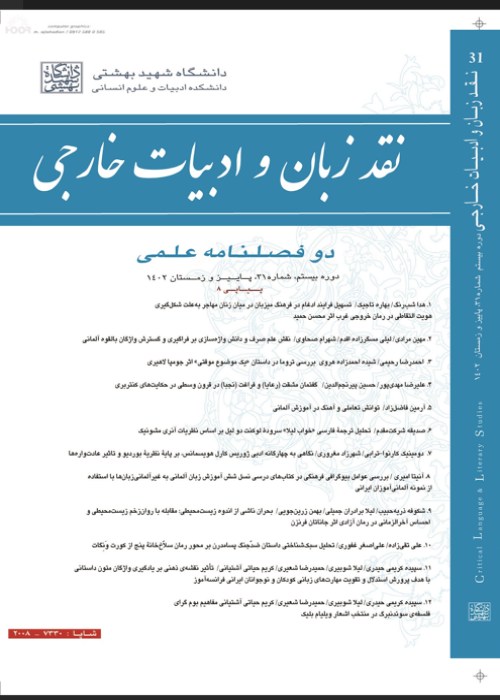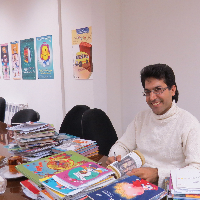A Comparison of Persian Translations of the Picture Book of "The Giving Tree": From the Perspective of the Interaction of Non-Verbal Elements
Author(s):
Article Type:
Research/Original Article (دارای رتبه معتبر)
Abstract:
Introduction
Non-verbal elements are the invisible conduit for transmitting the personal ideology of the translator and other translators idiots (art director, editor, publisher, etc.). Due to a large number of translations of Silverstein's "Giving Tree" from English to Persian, and the various readings of its commentators, this work has been chosen for the subject of translation of this article. The present research seeks to answer, how non-verbal elements (images, micro-patterns, pagination, typography, and font color) interact in the translated books of the mentioned work. . In the field of children's literature, the interaction of text and image has always been considered by theorists such as Scott and Nikolajeva. The innovation of the present study is that it generalizes their interactions from the level of text-image relationship to the level of non-verbal factors. The results show that the interaction of non-verbal elements is of five types: symmetric, complementary, expansive, counterpointing, and paradoxical. The cultural distance between the original language text and the translated text, as well as the prominent position of image, pagination, typography, etc. in the children's book publishing industry, necessitate performing the research. and in this regard, This research aims to answer three basic questions in the field of Persian translations of “The Giving Tree” (Silverstein, 2011): 1- How can the Nikolajeva-Scott (2019) Fifth Interaction Pattern, in terms of classifying types of image-text interactions, be generalized to, a model for classifying the types of interactions of non-verbal elements? 2. What are the differences and similarities between the different translations of “The Giving Tree” (Silverstein, 2011) in terms of the interaction of non-verbal elements (image, pagination, typography, miniatures, and font color)? 3- In the various translations of above- mentioned book, what are the types of interactions of non-verbal elements?Background
Mohsenianrad (2014), while quoting Bosmajian's definition, considers non-verbal communication channels to be very wide and expands its scope from facial expressions to fashion, from symbolic actions to dance, theater, pantomime, and music, from the influential currents of time to the flow of traffic, from brutal hegemony to clever diplomacy. In Iran, the articles that have been done on non-verbal communication, which have focused on the non-verbal communication of stories, have focused on the body language and the way the characters dress. Unlike studies conducted in Iran, which generally focus on the non-verbal element of body language, the subject of leading research is the axis of space (such as the proximity of pages in pagination, the proximity of images, and the like), and aesthetics (such as typography, miniatures, etc.).Research Methodology
through descriptive-comparative analytical methods, it compares semantic changes that the translation process has imposed on these interactions, with the original language text. The data in this article are taken from the original language book of “The Giving Tree”, by Silverstein, and the nine Persian translations of the book. In this research, in terms of non-verbal elements (image, typography, pagination, and font), each of these translations is compared with each other, and also the non-verbal elements of the translations, with their corresponding non-verbal elements, are adapted in the original language version. In this regard, the research expands the fivefold division of Scott-Nikolajeva, from the level of text-image interaction to the level of interaction of other non-verbal structures.Conclusion
This study shows that non-verbal elements enclose the text, like a glass frame, without being seen themselves. Many of the non-verbal elements of the books being translated are modified according to the culture and sphere of the target language. Thus, the non-verbal factors in the various translations of “The Giving Tree” (Silverstein, 2011) may not be semantically identical to the original language text; That is, texts can find new meaning through the interaction of non-verbal factors in line with the ideology of the translator, translation editor, and second publisher. Non-verbal image factors, pagination, and typography can enter into semantic interaction in five ways: symmetric, complementary, expansive, counterpointing, and paradoxical.When two non-verbal elements represent the same information, their type of interaction is "symmetrical interaction." When two non-verbal elements fill in each other's gaps, their interaction is of a "complementary interaction" type. To understand complementary interaction, the audience usually does not need conscious attention and receives this interaction, automatically and unknowingly. When two non-verbal elements expand the meaning of each other (usually the expansion of this meaning requires the conscious reflection and careful attention of the audience), then their relationship will be of the "expansion interaction" type. In the "hybrid interaction" situation, the two non-verbal elements each have a different narrative, and from their interaction, a new meaning is created, and without each of them, the decoding of the message is not accomplished. The most severe incompatibility between the two non-verbal elements occurs in "contradictory interaction."Keywords:
Language:
Persian
Published:
Critical Language & Literary Studies, Volume:19 Issue: 28, 2022
Pages:
169 to 198
magiran.com/p2480802
دانلود و مطالعه متن این مقاله با یکی از روشهای زیر امکان پذیر است:
اشتراک شخصی
با عضویت و پرداخت آنلاین حق اشتراک یکساله به مبلغ 1,390,000ريال میتوانید 70 عنوان مطلب دانلود کنید!
اشتراک سازمانی
به کتابخانه دانشگاه یا محل کار خود پیشنهاد کنید تا اشتراک سازمانی این پایگاه را برای دسترسی نامحدود همه کاربران به متن مطالب تهیه نمایند!
توجه!
- حق عضویت دریافتی صرف حمایت از نشریات عضو و نگهداری، تکمیل و توسعه مگیران میشود.
- پرداخت حق اشتراک و دانلود مقالات اجازه بازنشر آن در سایر رسانههای چاپی و دیجیتال را به کاربر نمیدهد.
In order to view content subscription is required
Personal subscription
Subscribe magiran.com for 70 € euros via PayPal and download 70 articles during a year.
Organization subscription
Please contact us to subscribe your university or library for unlimited access!



